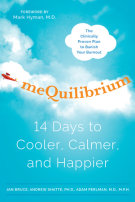
 meQuilibrium: 14 Days to Cooler, Calmer, and Happier, Jan Bruce, Andrew Shatte, and Adam Perlman, Harmony Books (2015)
meQuilibrium: 14 Days to Cooler, Calmer, and Happier, Jan Bruce, Andrew Shatte, and Adam Perlman, Harmony Books (2015)
These days, who isn’t stressed out or over-extended? Who couldn’t use a way to be cooler, calmer and happier? Resilience is a strength much needed in modern society. And the authors of this new book offer a two week plan to manage stress and build resilience.
I approached this book with a keen desire to be calmer and more resilient. I wanted to banish the burnout I felt slowly pulling me down, like quicksand. And the authors provided some excellent tools to help manage stress.
The book is divided into three parts: a short opening section describing the stress and missing peace. My guess is that if you read this book, you already know this. The closing section is just that: one chapter to help keep the new calmer you going. The meat of the book is in section two: the 14 day reboot. Each chapter is intended to be read for one day, focusing on the new tool and the exercise at the end of each chapter. These chapters are serial, building on each other, since some skills are fundamental to the rest.
The most powerful tool comes in day one: TMZ. To address the 7 powerhouse emotions (anger, anxiety, frustration, sadness, guilt, embarrassment and shame), the authors off the Trap It, Map It, Zap It approach, whereby you sensitize your emotional radar to recognize when you are falling into your pitfall emotion. Once trapped through early detection, you can map it, to connect it to the thought causing the emotion (and hence understand why this incident is causing this), then zap it by challenging the thought. My preponderant emotion is anger and I have used the TMZ approach to be calmer in a number of situations.
Day three offers a tool to unlock problem-solving power. The point is to understand various thinking traps and which ones you are susceptible to. Day four gives tools to be calmer, and the deep breathing techniques are very helpful. Day six suggest ways to navigate around iceberg beliefs.
Some of these tools and techniques are not new, such as the breathing and happy place ideas for calming oneself. But they are packaged holistically together in a presentable fashion. And they are proven to be helpful.
The book started out very strongly, but the chapters on sleep and eating waned a little. But after the iceberg chapter, I felt that book slowed down. Many of the chapters in days 7-14 focus on dealing with icebergs, although in specific situations.
On its own as a read, the book is quick and easy, but not very useful. Only when completing the exercises at the end of each chapter does this book come alive. And these are hard. Not in the sense of technically difficult, but in the requirement to dig deep within, to understand your inner self. Without such self-exploration, the book remains just that. With a commitment to work at each chapter, the book becomes a roadmap to inner growth.
I completed most of the chapter exercises and plan to come back to the ones that were too challenging for me at the time. Even with this, I feel I have become a little less stressed and a little more relaxed. If that’s what you want or need, I’d recommend this book. You’ll find something in it that will work for your life’s situation.
For more info: http://www.randomhouse.com/book/232259/mequilibrium-by-jan-bruce-andrew-shatte-phd-and-adam-perlman-md-mph
For more info: http://www.randomhouse.com/book/232259/mequilibrium-by-jan-bruce-andrew-shatte-phd-and-adam-perlman-md-mph
I received this book from Blogging for Books for this review.
